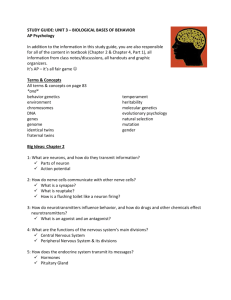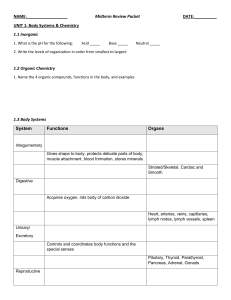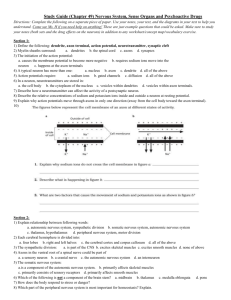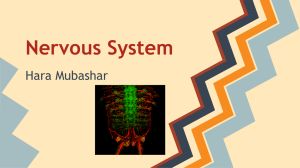Chapter 3 Vocabulary
advertisement
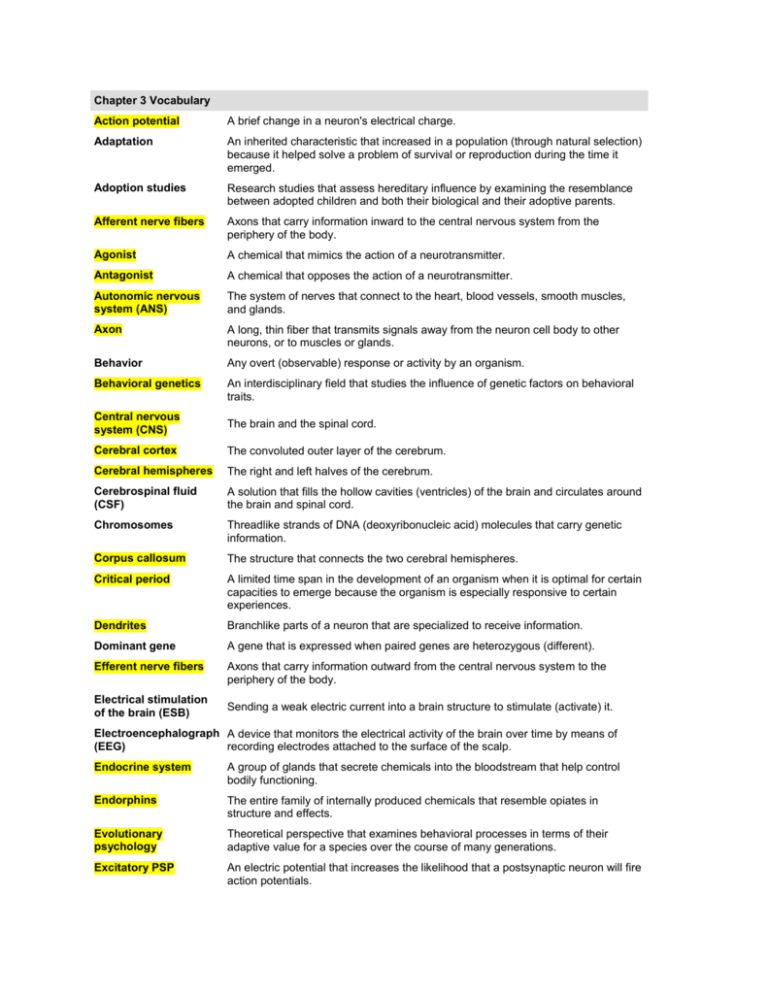
Chapter 3 Vocabulary Action potential A brief change in a neuron's electrical charge. Adaptation An inherited characteristic that increased in a population (through natural selection) because it helped solve a problem of survival or reproduction during the time it emerged. Adoption studies Research studies that assess hereditary influence by examining the resemblance between adopted children and both their biological and their adoptive parents. Afferent nerve fibers Axons that carry information inward to the central nervous system from the periphery of the body. Agonist A chemical that mimics the action of a neurotransmitter. Antagonist A chemical that opposes the action of a neurotransmitter. Autonomic nervous system (ANS) The system of nerves that connect to the heart, blood vessels, smooth muscles, and glands. Axon A long, thin fiber that transmits signals away from the neuron cell body to other neurons, or to muscles or glands. Behavior Any overt (observable) response or activity by an organism. Behavioral genetics An interdisciplinary field that studies the influence of genetic factors on behavioral traits. Central nervous system (CNS) The brain and the spinal cord. Cerebral cortex The convoluted outer layer of the cerebrum. Cerebral hemispheres The right and left halves of the cerebrum. Cerebrospinal fluid (CSF) A solution that fills the hollow cavities (ventricles) of the brain and circulates around the brain and spinal cord. Chromosomes Threadlike strands of DNA (deoxyribonucleic acid) molecules that carry genetic information. Corpus callosum The structure that connects the two cerebral hemispheres. Critical period A limited time span in the development of an organism when it is optimal for certain capacities to emerge because the organism is especially responsive to certain experiences. Dendrites Branchlike parts of a neuron that are specialized to receive information. Dominant gene A gene that is expressed when paired genes are heterozygous (different). Efferent nerve fibers Axons that carry information outward from the central nervous system to the periphery of the body. Electrical stimulation of the brain (ESB) Sending a weak electric current into a brain structure to stimulate (activate) it. Electroencephalograph A device that monitors the electrical activity of the brain over time by means of (EEG) recording electrodes attached to the surface of the scalp. Endocrine system A group of glands that secrete chemicals into the bloodstream that help control bodily functioning. Endorphins The entire family of internally produced chemicals that resemble opiates in structure and effects. Evolutionary psychology Theoretical perspective that examines behavioral processes in terms of their adaptive value for a species over the course of many generations. Excitatory PSP An electric potential that increases the likelihood that a postsynaptic neuron will fire action potentials. Extraverts People who tend to be interested in the external world of people and things. Family studies Scientific studies in which researchers assess hereditary influence by examining blood relatives to see how much they resemble each other on a specific trait. Fight-or-flight response A physiological reaction to threat in which the autonomic nervous system mobilizes the organism for attacking (fight) or fleeing (flight) an enemy. Fitness The reproductive success (number of descendants) of an individual organism relative to the average reproductive success of the population. Forebrain The largest and most complicated region of the brain, encompassing a variety of structures, including the thalamus, hypothalamus, limbic system, and cerebrum. Fraternal twins Twins that result when two eggs are fertilized simultaneously by different sperm cells, forming two separate zygotes. Also called Dizygotic twins. Genes DNA segments that serve as the key functional units in hereditary transmission. Genetic mapping The process of determining the location and chemical sequence of specific genes on specific chromosomes. Genotype A person's genetic makeup. Heterozygous condition The situation that occurs when two genes in a specific pair are different. Hindbrain The part of the brain that includes the cerebellum and two structures found in the lower part of the brainstem: the medulla and the pons. Homozygous condition The situation that occurs when two genes in a specific pair are the same. Hormones The chemical substances released by the endocrine glands. Hypothalamus A structure found near the base of the forebrain that is involved in the regulation of basic biological needs. Identical twins Twins that emerge from one zygote that splits for unknown reasons. Also called Monozygotic twins. Inclusive fitness The sum of an individual's own reproductive success plus the effects the organism has on the reproductive success of related others. Inhibitory PSP An electric potential that decreases the likelihood that a postsynaptic neuron will fire action potentials. Learning A relatively durable change in behavior or knowledge that is due to experience. Lesioning Destroying a piece of the brain. Limbic system A densely connected network of structures roughly located along the border between the cerebral cortex and deeper subcortical areas. Midbrain The segment of the brain stem that lies between the hindbrain and the forebrain. Monogamy A mating system in which one male and one female mate exclusively, or almost exclusively, with each other. Mutation A spontaneous, heritable change in a piece of DNA that occurs in the individual organism. Myelin sheath Insulating material, derived from glial cells, that encases some axons of neurons. Natural selection Principle stating that heritable characteristics that provide a survival reproductive advantage are more likely than alternative characteristics to be passed on to subsequent generations and thus come to be “selected“ over time. Nerves Bundles of neuron fibers (axons) that are routed together in the peripheral nervous system. Neurons Individual cells in the nervous system that receive, integrate, and transmit information. Neurotransmitters Chemicals that transmit information from one neuron to another. Parasympathetic division The branch of the autonomic nervous system that generally conserves bodily resources. Parental investment What each sex invests-in terms of time, energy, survival risk, and forgone opportunities-to produce and nurture offspring. Perceptual asymmetries Left-right imbalances between the cerebral hemispheres in the speed of visual or auditory processing. Peripheral nervous system All those nerves that lie outside the brain and spinal cord. Phenotype The ways in which a person's genotype is manifested in observable characteristics. Pituitary gland The “master gland“ of the endocrine system; it releases a great variety of hormones that fan out through the body, stimulating actions in the other endocrine glands. Polyandry A mating system in which each female seeks to mate with multiple males, while each male mates with only one female. Polygenic traits Characteristics that are influenced by more than one pair of genes. Polygyny A mating system in which each male seeks to mate with multiple females, while each female mates with only one male. Population The larger collection of animals or people from which a sample is drawn and that researchers want to generalize about. Postsynaptic potential (PSP) A voltage change at the receptor site on a postsynaptic cell membrane. Primary sex characteristics The sexual structures necessary for reproduction. Puberty The period of early adolescence marked by rapid physical growth and the development of sexual (reproductive) maturity. Recessive gene A gene whose influence is masked when paired genes are different (heterozygous). Refractory period A time following orgasm during which males are largely unresponsive to further stimulation. Resting potential The stable, negative charge of a neuron when it is inactive. Reuptake A process in which neurotransmitters are sponged up from the synaptic cleft by the presynaptic membrane. Secondary sex characteristics Physical features that are associated with gender but that are not directly involved in reproduction. Soma The cell body of a neuron; it contains the nucleus and much of the chemical machinery common to most cells. Somatic nervous system The system of nerves that connect to voluntary skeletal muscles and to sensory receptors. Split-brain surgery A procedure in which the bundle of fibers that connects the cerebral hemispheres (the corpus callosum) is cut to reduce the severity of epileptic seizures. Sympathetic division The branch of the autonomic nervous system that mobilizes the body's resources for emergencies. Synapse A junction where information is transmitted from one neuron to the next. Synaptic cleft A microscopic gap between the terminal button of a neuron and the cell membrane of another neuron. Terminal buttons Small knobs at the end of axons that secrete chemicals called neurotransmitters. Thalamus A structure in the forebrain through which all sensory information (except smell) must pass to get to the cerebral cortex. Twin studies A research design in which hereditary influence is assessed by comparing the resemblance of identical twins and fraternal twins with respect to a trait. Zygote A one-celled organism formed by the union of a sperm and an egg.

